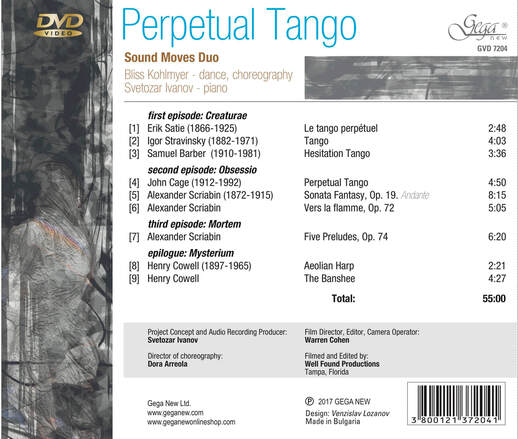Perpetual Tango
Svetozar Ivanov - piano, project concept, film director
Bliss Kohlmyer - dance, choreography
Warren Cohen - film editor
Svetozar Ivanov - piano, project concept, film director
Bliss Kohlmyer - dance, choreography
Warren Cohen - film editor
Perpetual Tango
inspired by Jean Cocteau's film " Le sang d'un poète"
first episode: CREATURAE (1:04)
Erik Satie - Le tango perpetuei
Igor Stravinsky - Tango (1940)
Samuel Barber - Hesitation Tango
second episode: OBSESSIO (16:50)
John Cage - Perpetual Tango
Alexander Scriabin - Sonata Fantasy, op.19
Alexander Scriabin - Vers la flamme, op.72
third episode: MORTEM (35:36)
Alexander Scriabin - Five Preludes, op.74
epilogue: MYSTERIUM (45:48)
Henry Cowell - Aeolian
Harp Henry Cowell - The Banshee
inspired by Jean Cocteau's film " Le sang d'un poète"
first episode: CREATURAE (1:04)
Erik Satie - Le tango perpetuei
Igor Stravinsky - Tango (1940)
Samuel Barber - Hesitation Tango
second episode: OBSESSIO (16:50)
John Cage - Perpetual Tango
Alexander Scriabin - Sonata Fantasy, op.19
Alexander Scriabin - Vers la flamme, op.72
third episode: MORTEM (35:36)
Alexander Scriabin - Five Preludes, op.74
epilogue: MYSTERIUM (45:48)
Henry Cowell - Aeolian
Harp Henry Cowell - The Banshee
Perpetual Tango is inspired by Jean Cocteau’s 1930 film “Le sang d’un poète” (“The Blood of a Poet”), a work that pays tribute to the artistic process. Through a series of poetic and abstract images, Cocteau presents an artist who gradually becomes obsessed with his creation, to the extent that it comes to life and takes control of the artist’s actions. What follows is a series of disappointments leading to a suicide of his artistic self. The artistic effort is portrayed as a dark, self-inflicting act of suffering. States of being, transformation, and liminality are guiding forces in Perpetual Tango as the dancer transcends from one state to another. The movements physicalize the space in between earth/spirit, mortal/immortal, and visible/invisible.
